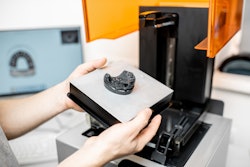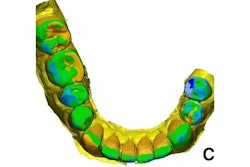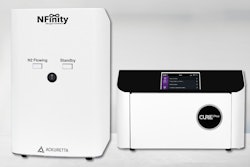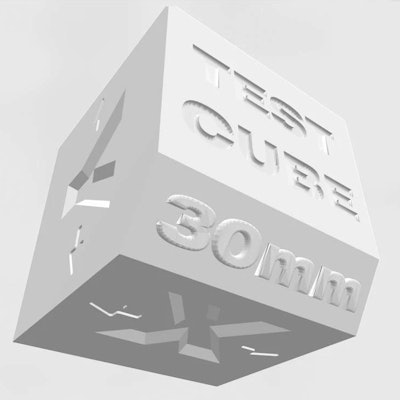
3D printing is becoming a staple of modern dentistry, and the technology is a big investment for practices. A study published May 26 in BDJ Open compared the accuracy of 12 common printers used in dentistry to see whether a higher price point equates to better quality.
Researchers judged the dimensional accuracy of 12 3D printers spanning a wide variety of budgets, including models from Planmeca, Envisiontec, and 3D Systems. Although the printers use different technologies, no type of printer technology proved to be more accurate than other technologies.
Because there is no statistical superiority in regard to dimensional accuracy, "general dental practices with a lower budget can also access 3D printing technologies to benefit patients with an easier way of creating a model in a more predictable and repeatable way to alleviate problems or complications encountered in conventional methods when making impressions," the study author, Adam Nulty of the International Digital Dental Academy in London, wrote.
The study assessed the accuracy of 3D printers using technologies for resin chairside production using a standardized printable test block.
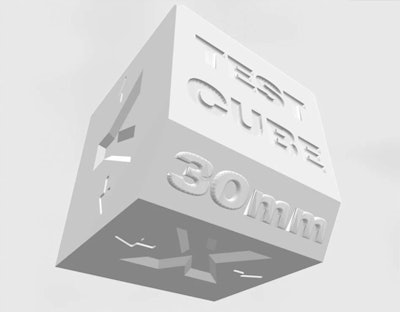 The 3D standard tessellation language (TSL) test cube, which was printed on each printer reviewed in the study. Image courtesy of BDJ Open.
The 3D standard tessellation language (TSL) test cube, which was printed on each printer reviewed in the study. Image courtesy of BDJ Open.All test blocks were printed using the same settings with 100 micron Z layer thickness and standard set print time where applicable. Calibration and postprint processing instructions were followed according to the manufacturers' instructions. Workflows included an alcohol wash and curing appropriate for the resin used.
| Mean deviation of each printer compared to master STL | ||||
| Manufacturer | Printer | X axis | Y axis | Z axis |
| 3D Systems | Nextdent 5100 | 0.053 (±0.048) | 0.051 (±0.049) | 0.019 (±0.079) |
| Ackuretta | Sol | 0.030 (±0.052) | 0.025 (±0.034) | 0.023 (±0.028) |
| Anycubic | Photon | 0.064 (±0.103) | 0.061* (±0.026) | -0.016 (±0.025) |
| Photon S | 0.064 (±0.101) | 0.068* (±0.026) | -0.016 (±0.025) | |
| Asiga | Max UV | 0.041 (±0.064) | 0.032 (±0.038) | -0.021 (±0.020) |
| Elegoo | Mars | 0.072 (±0.083) | 0.056 (±0.051) | -0.044 (±0.035) |
| Envisiontec | D4K Pro | -0.028 (±0.037) | 0.021 (±0.030) | -0.028 (±0.037) |
| Envision One | -0.035 (±0.045) | -0.028 (±0.037) | 0.030 (±0.021) | |
| Envisiontec | Vida HD | 0.045 (±0.047) | -0.019 (±0.045) | 0.262* (±0.026) |
| Formlabs | Form 2 | 0.142 (±0.111) | 0.149 (±0.094) | 0.146* (±0.012) |
| Formlabs | Form 3 | 0.116* (±0.042) | 0.108 (±0.067) | -0.047 (±0.064) |
| Planmeca | Creos | 0.038* (±0.016) | -0.036 (±0.022) | -0.053* (±0.027) |
No technology was statistically superior to the others, Nulty said. The cheapest 3D printers in the group, the Anycubic printers and the Elegoo Mars, did not create statistically different results compared to the higher-priced Envisiontec and Asiga Max UV printers.
While there were no statistical differences in terms of accuracy and trueness, 3D printers developed specifically for the dental market have clear advantages, the author wrote. The Asiga Max UV has in-built technology, including pressure sensors to increase printing speed, and the Ackuretta Sol is a dental-specific printer with a wide range of resign profiles calibrated and built into the software. The D4K Pro by Envisontec has resins which are licensed exclusively for the brand.
Study findings show that the current range of 3D printers can produce clinically acceptable levels of accuracy, and all of the 3D printers evaluated in this study can produce reliable and reproducible models. Developments in modern dentistry within CAD/CAM, digital impression registration, and chairside production are fast paced, which means that 3D printing will most likely be used more within dentistry as the technologies advance.
"The evolution of 3D printers that leads to budget printers being as statistically accurate ... as expensive printers is remarkable," the study author concluded.




